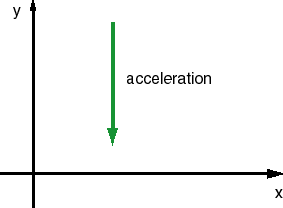

In the following equations for the motion of a freely falling particle near the earth's surface it is assumed that an x,y coordinate system has been chosen as illustrated above and that there is the same downward acceleration everywhere. The magnitude of this acceleration is denoted g. The value of g varies somewhat from one location to another. It is smallest at the equator and largest at the poles. To two significant figures, g = 9.8 m/s2.
Acceleration, velocity, and position vs. time:
| Horizontal (x) | Vertical (y) | |
| Acceleration | ax = 0 | ay = -g |
| Velocity | vx(t) = vx(0) = const | vy(t) = vy(0) - gt |
| Position | x(t) = x(0) + vx(0)t | y(t) = y(0) + vy(0)t - g/2 t2 |
Speed vs. displacement:
Δv2 = v2(t) - v2(0) = -2gΔy = -2g[y(t) - y(0)]
wherev2 = vx2 + vy2.
Note. The equations listed here are special cases of the kinematic equations for motion with constant acceleration. They apply to the case where ax = 0 and ay = -g. They apply only when there is no air resistance, because only then is the acceleration constant in projectile motion.